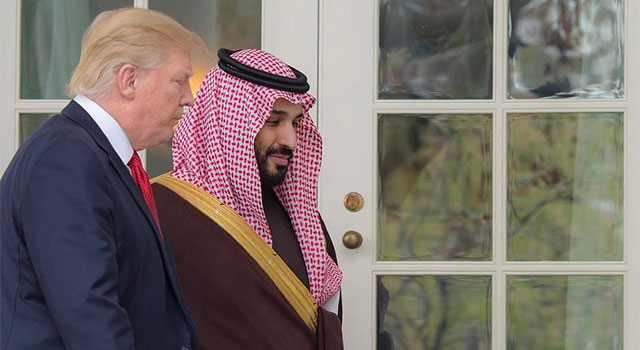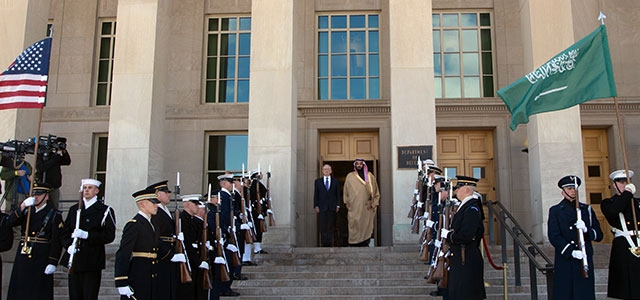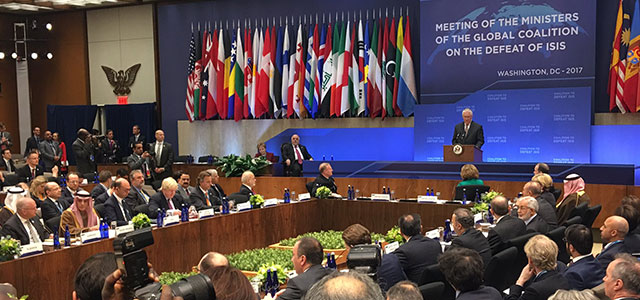The last ten days were dramatic and, potentially in their own way, historic. The occasion was a visit to the United States by the Saudi Arabian Deputy Crown Prince and Minister of Defense, HRH Prince Mohammed bin Salman. The setting was at once stirring as was the atmosphere laced with a degree of uncertainly given some of the perceived, media-fed strains in the U.S.-Saudi Arabian relationship over the past several years.
Not least among the reasons the visit was so portentous are the following:
First, only days before the Deputy Crown Prince’s arrival the Trump administration had slapped punitive sanctions on half-a-dozen Muslim-majority countries, of which all but Iran are Arab nations.
Second, the visit came on the heels of ongoing uncertainties over the implications of significantly plummeted international oil prices since 2014. What each side will do about this sea change in the price of the strategic commodity that drives the engines of the world’s economies remains to be seen. One of the key dimensions of the likely near-term outcome turns for a greater extent than ever before on discussions between the Arab-led OPEC nations, on one hand, and key non-OPEC countries such as the United States and Russia, on the other.
Third, the Kingdom’s and America’s leaders convened at a moment when the growing encirclement of ISIS in Mosul, Iraq’s third-largest city, is fraught with an uncertain finale. More open to question is what will likely follow the eventual routing of one of the most lethal and debilitating scourges to have dominated parts of the Arab landscape in history.
Similar uncertainty underpins any sound analysis and assessment of the near term future of Syria. Russia, Iran, and Hezbollah, among the foreign forces that have tipped the balance in favor of the Assad regime in Damascus, are undoubtedly riding high at the moment. It remains to be seen, however, what the fate and future will be of the remaining opposition groups, including, in particular, the separatists, or at a minimum pro-autonomy, Kurdish forces in the country’s northeast.
Fourth, the nature, content, and extent of U.S.-Saudi Arabia cooperation in counter-terrorism going forward has, understandably, remained high in the national strategic imperatives of both countries’ needs, concerns, and interests.
Fifth, the two countries remain, for better or worse, locked in an inevitable strategic, national security, and defense cooperation-related relationship of the upmost importance as it pertains to Yemen. This is despite the growing anti-American involvement sentiment regarding this campaign in the media, so-called think tanks, and in rising numbers of members of Congress. Many of those favor, at most, a halt to further U.S. arms exports to the Kingdom, and, at minimum, a cessation of deliveries of munitions and ordnance designated for the two year old multinational coalition campaign to restore the legitimate government of Yemeni President Abed Rabbo Mansour Hadi.
Americans need to know there will be no slackening in this component of the two countries defense relationship. Indeed, there will be likely no slackening in the two countries determination to ensure that the conflict in Yemen, aided and abetted by Iran, does not further threaten the security and stability of the Kingdom. Nor will there be any willingness to further enhance Iran’s Shia-centric objective of expanding Tehran’s appeal to and influence over the region’s Shia Muslim people beyond that which it has already achieved.
Finally, the visit should help to put to rest the unseemly innuendo of the past year in which there were reports that President Barack Obama considered, if not Saudi Arabia itself, then those in its camp “free riders.” In reality, a persuasive argument could be made that the reverse is the case.
For the later perspective, consider those American livelihoods that turn directly on Saudi Arabia’s tens of billions of dollars of purchases of American goods and services. The tens of thousands of full-paying Saudi Arabian students at American universities. The tens of thousands of Americans whose livelihoods are derived from living and working in the Kingdom, versus no comparable number of Saudi Arabians taking money out of the United States. This is in addition to the Kingdom’s rock-solid support, against all competitors, for ongoing reliance upon the American dollar as the instrument of exchange in all of its international economic and financial transactions. The benefits of that alone have aided mightily in the ongoing preeminence of the American monetary banking system worldwide.
These are but a few of the bountiful and poorly-understood American benefits that derive from the eighty-year old, unapologetically special relationship between our two peoples. As Fahad Nazer’s insightful essay thoughtfully illustrates, one ought not to count on any near- or long-term jettisoning of the reciprocal rewards that remain embedded in these extraordinary special ties that remain the envy of practically every other nation in the world.
Dr. John Duke Anthony
Founding President and CEO
National Council on U.S.-Arab Relations
Washington, DC
![]()
Over a quarter-century ago, the United States and Saudi Arabia fought side by side in Operations Desert Shield and Desert Storm. They did so to reverse Iraq’s August 1990 aggression against Kuwait. Afterwards, as to whether the United States and Saudi Arabia were friends, both answered “yes” unequivocally.
If the first two months of Donald Trump’s presidency are any indication, bilateral ties might return to their “Kuwait Crisis” heyday. That was when both countries’ officials routinely characterized them as “special.”
Last week, Saudi Arabia’s Deputy Crown Prince and Minister of Defense, HRH Prince Mohammed bin Salman, visited Washington. Accompanied by foreign affairs and defense policy advisers, Prince Mohammed met with President Trump at the White House on March 14 and with U.S. Secretary of Defense General (Ret.) Jim Mattis at the Pentagon on March 16. The visit’s timing and the meetings themselves, as well as the statements issued by the American and Saudi Arabian participants, suggest that both countries’ leaders agree on a wide array of political and economic issues and policies. This bodes well for their future relations. To the envy of many, these ties have endured for the past eight decades. What is more, they have broadened and strengthened on many levels.

The timing of the visit – less than two months after President Trump’s inauguration – was at once indicative and propitious. To critics, it was too soon. To others, it emphasized yet again the importance that the two countries accord their relations. It highlighted the keenness of both countries’ leaders to establish good personal relations early in the Trump administration.
The Kingdom’s leaders are already familiar with Secretary Mattis from when he was the Commander of U.S. Central Command, and with National Security Adviser Lieutenant General H.R. McMaster dating back to the liberation of Kuwait and his important later role in the 2003 Iraq War. As the former chief executive of one of the world’s biggest energy companies, ExxonMobil, U.S. Secretary of State Rex Tillerson is also a well-known and highly-respected commodity in Saudi Arabia. Not only does he appear to have a nuanced understanding of the complex intersection between politics and economics. He also appreciates the role that Riyadh has played over the years in keeping international oil markets balanced and stable.
The visit provided Prince Mohammed and his deputies the opportunity to meet with some of President Trump’s other trusted but lesser-known advisers. These include White House Chief Strategist Steve Bannon and Senior Adviser Jared Kushner. The latter has been touted as destined to play a key role in matters pertaining to Arab-Israeli peace.
The footage of Prince Mohammed’s meeting with President Trump at the White House was telling. So, too, was that of the lunch the President hosted for him afterward. Both were evidence of the appreciation that the White House has for the history of the U.S.-Saudi Arabian relationship. At the same time, the meetings suggested that President Trump also understands the important role that Prince Mohammed plays in shaping Saudi Arabia’s political and economic trajectory.
The meetings suggested that President Trump understands the important role that Prince Mohammed plays in shaping Saudi Arabia’s political and economic trajectory.
The comfort level between senior officials on both sides was jocular. Secretary Mattis joked with Saudi Arabian Foreign Minister Adel A. Al-Jubeir when he met him at the Pentagon. He said, “It is always good to see you alive. The Iranians tried to murder you.” The Minister also met with Secretary Tillerson. By all accounts, the meetings covered many issues of concern to both nations and went well.
At the Pentagon meeting, Prince Mohammed expressed his appreciation for the durability of the ties between the two countries. He acknowledged that they face many challenges. These include those posed by terrorist groups and Iran’s politics of destabilization. “This is not the first time we have faced challenges together,” he stressed.
The prince asserted that Saudi Arabia was on the “frontline” of these challenges. In so doing, he underscored the United States’ vital role in maintaining stability in the region, referring to it as “the leader of the world.” Prince Mohammed also displayed his characteristic frankness in cautioning that Saudi Arabia has been the primary target of terrorist groups. Should they overtake it, he was keen to make clear, they will “control the rest of the Islamic world.”

An adviser to the Deputy Crown Prince and Minister of Defense released a statement expressing the Kingdom’s appreciation for President Trump and Prince Mohammed’s meeting. It noted the meeting represented a “historic turning point” and a shift in the relationship. The statement did not dwell on the “period of difference of opinion” the two countries had in recent years, a clear reference to the previous administration of President Barack Obama. Instead, it stressed the many policy areas in which the two countries agree.
Also in that statement, Saudi Arabia publicly commented for the first time on President Trump’s executive order that restricted travel to the U.S. from six predominantly-Muslim countries. On this issue, the statement said, “Saudi Arabia does not believe that this measure is targeting Muslim countries or the religion of Islam. This measure is a sovereign decision aimed at preventing terrorists from entering the United States of America.” It also added that President Trump “expressed his deep respect for the religion of Islam.”
Over the past two months, it has become apparent that Saudi Arabian and United States leaders agree that the political violence and instability that have convulsed the region over the past several years require assertive and clear foreign policies. The turmoil also requires both countries to be fully engaged, as opposed to viewing mere avoidance of any involvement as a moral victory. The Trump administration and Saudi Arabian leadership see each other as being uniquely positioned to play a critical role in stabilizing the region; the U.S. because of its military power and Saudi Arabia because of its eminent status in the Islamic world.
Shortly after President Trump was inaugurated, Saudi Arabian Foreign Minister Al-Jubeir said during an interview that he anticipated that the U.S. would be more engaged on the world stage than it had been in recent years. That appears to be the case. The U.S. is beginning to assert itself more in the wars in Yemen and Syria. Understanding the dynamics of the myriad of conflicts convulsing the region and their impacts on neighboring countries is vital if greater stability is going to be achieved.

While the outline of a “Trump Doctrine” is still being delineated, one thing is clear: President Trump has declared that defeating ISIS – or as many prefer to call it, Daesh – will be his top foreign policy priority. He was consistent regarding this objective during his presidential campaign and has maintained that position since assuming the presidency.
To accomplish that goal, the United States needs to continue its close security and counter-terrorism cooperation with Saudi Arabia. The Trump administration appears to understand that the Kingdom is an indispensable ally in the fight against ISIS. For example, Saudi Arabia’s participation in the U.S.-led military campaign against ISIS strongholds in Syria has precluded critics from portraying it as a Western war against Muslims.
One of the keys to the durability of U.S.-Saudi Arabian relations has been the fact that they are multidimensional. Saudi Arabia continues to play a vital role in stabilizing international energy markets. Riyadh, meanwhile, appreciates the unique role the United States plays in bringing stability to the Middle East and in maintaining the international political order.
Saudi Arabia’s pre-eminence in the Islamic and Arab worlds has been acknowledged by successive U.S. administrations. In addition, the level of trade between the two countries has increased over the years, totaling an estimated $35 billion in 2016. There are also robust cultural and educational exchanges, including more than 60,000 Saudi Arabian students currently enrolled in United States institutions of higher education.
One of the keys to the durability of U.S.-Saudi Arabian relations has been the fact that they are multidimensional.
Critical to the success of Saudi Arabia’s Vision 2030 national development plan is attracting foreign direct investment. Prince Mohammed is the architect of Vision 2030, and as such has met with CEOs of many American financial institutions and technology companies. Saudi Arabians have a certain level of comfort with American companies because of their long and successful history in the Kingdom. For their part, many American companies view the various sectors of the Saudi Arabian economy being liberalized under the Vision 2030 plan as good investment opportunities.
Yet mutual interests are only part of the picture. U.S. and Saudi Arabian leaders have made clear that they are not only committed to strengthening bilateral ties, they are also attuned to finding the best means to do so. In other words, the two nations are putting a high premium on the arts of statecraft and diplomacy.
Senior Trump officials and advisers appreciate that Saudi Arabia is undergoing “massive change,” in the words of former New York City Mayor Rudolph Giulliani. A similar sentiment was expressed by Secretary Tillerson during his Senate confirmation hearing. At the same time, Saudi Arabian leaders understand that the new U.S. administration has its own challenges in terms of implementing its domestic policy agenda.
A convergence on the efficacy of positive reinforcement by stressing the many strengths of their bilateral relationship will likely go a long way toward enhancing the much-coveted “special” status Saudi Arabian-U.S. relations enjoy. Indeed, it should not come as a surprise if President Trump makes Riyadh his first stop on his first official state visit to the Middle East.
Author
-

Mr. Fahad Nazer is an International Affairs Fellow with the National Council on U.S.-Arab Relations. He is also a political consultant to the Embassy of Saudi Arabia in Washington. However, he does not represent it or speak on its behalf. His writing has appeared in The New York Times, Foreign Affairs, Foreign Policy, CNN, The Hill, and Newsweek, among others.
